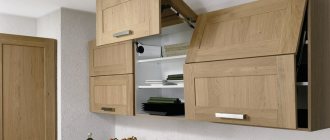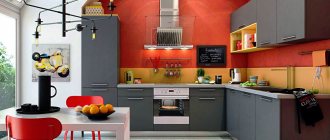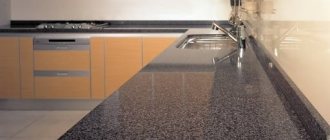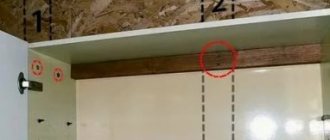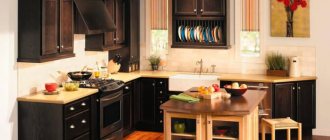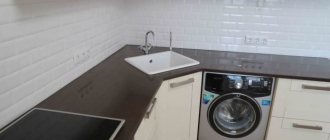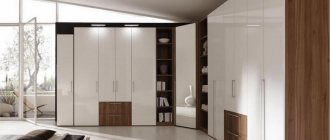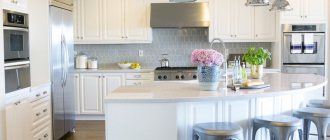The kitchen is the most attractive place in the apartment, where the family gathers in the evening for dinner, where you can escape from pressing problems. And I really want comfort. And to create it, you need to carry out repairs and arrange furniture. And here some points that directly affect the convenience of the kitchen and its functionality are important.
Beautiful cozy kitchen with furniture in a modern style
An ideal spacious kitchen with spacious floor cabinets and no wall units
Each kitchen has a suite, including wall cabinets. It's comfortable. But you need to choose the right height for the cabinets, where you mainly keep dishes and cans of cereals. As you can see, the load is heavy. It is necessary to ensure reliable fastening. Let's figure out at what height to hang kitchen cabinets.
Minimum and maximum height of wall cabinets relative to the working surface
Standard height standards for kitchen cabinets
First of all, standards for heights, basic dimensions and distances between individual furniture elements are regulated by GOST standards. The standards given in them help to maintain ergonomics in the placement of furniture, which ultimately helps to simplify the cooking process without experiencing any extraneous stress on the body.
According to the standard, the distance between the upper and lower kitchen cabinets does not exceed 60 cm.
Height of upper cabinets
It is recommended to limit the location of the edge of the upper tier of furniture to 1.9 m. Moreover, this standard is given regardless of the height of the ceiling. These restrictions allow you to freely place the hood above the stove, regardless of its dimensions.
For housewives up to 160 cm tall, the upper cabinets are suspended at a height of 165 cm from the floor.
If this technique is used when operating electric stoves, the hood is installed at a distance of 70 cm from the surface; 80 cm is required for appliances running on gas. If a person is tall, it is permissible to increase the distance of the lower edge of the hood from the surface of the hob or stove to 90 cm.
The height is measured from the top edge. The general formula is a person’s height and an additional distance of up to 25 cm.
The bottom shelf of such a row should be located at a distance of 1.5 m from the floor. With this arrangement, there is enough space between the lower and upper tier of the kitchen, which will not cause unnecessary inconvenience during the cooking process.
Hanging cabinets high so that you can reach the shelves by standing on a chair is not recommended unless you have items that are rarely used.
Height of base cabinets
The calculation of the lower tier is based on the size of the upper one. According to the standard, there must be at least 90 centimeters of free space between the bottom edge of wall cabinets and the countertop. This allows you to have enough freedom to prepare even the most complex dish consisting of many ingredients.
When installing furniture, you should, first of all, focus on your needs and the specific tasks that it must solve.
Most often, when making a kitchen, we take into account the individual parameters of the people who will use the furniture. So, if any of the family members is too tall or short, the sizes and relationships between the rows of furniture can be revised in one direction or the other. We will consider recommendations for this case below.
It should be said that there is no single standard parameter that will suit any person and satisfy all his whims.
Methods for attaching wall cabinets
There are only 2 ways:
- On the mounting plate.
- On hinges.
To hang cabinets, it is necessary not only to determine the optimal height, but also to make the correct and reliable fastening. The fixing parts must be designed for heavy weight. The correct technology and sequence of actions are also important - to check functionality, assemble and adjust to a finished state. It is correct to start installation from the corner section or from the wall against which the structure should rest. If the method of mounting on a rail (bar) is used, any other direction of installation is impossible in principle. This rule cannot be ignored when installing on hinges. Otherwise, there will be problems with aligning the heights of the sections. The distances between them will be unequal or incorrect. Unnecessary gaps may appear. In addition, you may not “calculate” the distances and end up not finding space for another locker.
On the mounting plate
This is a more modern fastening method. In this case, the load is distributed evenly along the entire length of the facade. This type of installation leaves it possible to adjust the height of the suspended structure. The elements are installed one by one, so even one person can handle the task. Work must be carried out strictly in a certain order. First, the upper and lower boundaries of the location of the cabinets are marked on the wall. Then markings are applied under the bar. Next, holes are drilled and the fittings for the rail are fixed. After this, the rail itself is installed and the elements are hung. They are first mounted without shelves and doors. It is better to mount cabinets closely - special fasteners are used for this. At the end, shelves are installed and façade surfaces are attached. The latter can be adjusted immediately if they are slightly tilted to the side.
Loops
You can hang a cabinet of any configuration on the hinges. This method is convenient, including for installing single structures. If there are a lot of elements, then a level will be needed in the work. If several boxes have been connected, installation will require two people. The algorithm of actions of this method and the method with a mounting strip are partially similar. However, in this case, a hole is drilled for the dowels. You will need to fix the hinges on the back walls of the cabinets (at the top). It is better to use self-tapping screws as fixing elements. You can make the fasteners in advance. The sections are mounted on dowels. It is better to fasten adjacent modules. To reduce the likelihood of chipping to a minimum, you should drill narrow holes for the screws and then widen them. You can also apply a beam on the other side to reduce vibration from drilling. The final stage is the installation of shelves and doors.
Growth of living space inhabitants
The calculation begins with the growth of residents. The placement of wall cabinets that is suitable for short people may not be suitable for tall people, and vice versa. A quick option is to arrange the shelves and wall cabinets so that the top edge of the kitchen set is no higher than 25 cm from the top of the head. Another formula is used: the middle shelf of the cabinet is placed at eye level.
The distance from the lower to the upper shelves, if not adjusted in height to the height of the hostess, will cause her inconvenience when preparing food. The area of the kitchen, the location of the gas stove and refrigerator, and the height of the ceilings in the house or apartment are also taken as initial data for the calculation.
Top row dimensions
According to the observations of kitchen furniture manufacturers, wall-mounted modules are used 3 times more often than the bottom row. It is believed that wall sections are used for storing frequently used products and items, and floor sections are used for bulky equipment and utensils.
Placing the top units too low can lead to injury during kitchen work. Placing wall drawers too high is inconvenient: to get dishes or food, you will need a stepladder or stool. The width of the top section matches the bottom row. The standard for placing furniture in the kitchen is selected for a height of 165 cm; for short people, the hanging modules are lowered, and for tall people they are raised. The top shelf of the cabinet is located near the outstretched hand.
Typical wall sections have the following parameters:
- place hanging drawers above the work surface at a height of 45-60 cm (the height of the kitchen owner is taken into account);
- height of wall sections - 70-90 cm;
- depth—30 cm;
- width – from 15 to 90 cm;
- corner design - 60x60 cm.
A tier with a niche for placing a microwave oven is made about 35-38 cm high with an open lower shelf, the depth of which is also 35 cm. Such a niche can be combined with a hanging section or represent a separate module. The shelf width is from 56 cm. The hood is installed 80 cm above the gas stove and 70 cm from the electric surface. Hanging the hood higher reduces the speed and efficiency of its operation; low placement affects the duration of operation of the equipment: the hood may break due to overheating.
Correct placement of kitchen wall cabinets on free walls
On free walls, kitchen wall cabinets do not have to be placed in one line. They can be placed in a checkerboard pattern, cascade or wave. The main thing is that the resulting design fits harmoniously into the overall design.
The dimensions and depth of such cabinets can also vary. Models should look attractive on the wall, be comfortable and functional.
Successful examples of planning and design
Wall cabinets in the kitchen are used not only for storing food and dishes. Often they perform a purely decorative function. If the kitchen is large and there is no need to place spacious cabinets on a wall free from the countertop and sink, create attractive combinations of small open and closed cabinets.
The layout of the kitchen space is based on the identification of a working triangle. In its corners there is a sink, hob and refrigerator. This is the most convenient placement of kitchen furniture and utensils, allowing you to save time when preparing food.
Examples of layouts with hanging cabinets placed on a free wall:
- Parallel. It involves placing a sink and stove on one wall, and household appliances, including a refrigerator, on the other. In this case, wall cabinets are required to accommodate the microwave oven and bulk products. In addition to them, the free parts of the wall can be decorated with decorative elements and even a TV can be placed on them. This option is most convenient if there are two entrances to the kitchen.
- U-shaped. With this layout, one of the elements of the working triangle is placed at each wall. You can separately place a dining area, as well as a bar counter. Above the bar counter, small wall cabinets with dishes and decorations that complement the decor look beautiful.
Using wall cabinets of different heights in the kitchen
Modern kitchens often have kitchen cabinets of different heights. At the same time, in tall models they store those items that the owner does not want to display, and low cabinets are used as additional shelves. They place a vase, bright jars with spices and other decorative items.
Cabinets made of several modules are also widely used in kitchen interiors. The sections of such models can be placed in any order. If the sequence of their placement changes, the system does not cease to be neat and complete.
Narrow and wide
Models for domestic use with a standard height (60 cm) can vary significantly in width. The narrowest of them are 45 cm. Such stoves usually have only basic functions, but they can be placed in a compact vertical module, such as a side cabinet, at tabletop level. A convenient option, especially relevant for families with small baking needs.
Despite its small size, the Maunfeld MEOXN.376RCC.TA oven costs about 50 thousand rubles
Wide ovens (up to 90 cm) are powerful, expensive devices capable of operating in a wide range of modes (12 or more). To install such a stove at the level of the working area, you will need a fairly large frame. Therefore, they are most often located in floor cabinets, below the countertop, under the hob.
An example of building a wide oven into a kitchen cabinet
Working triangle rule
There are several ideas with which you can arrange all the structures, sink, stove, as well as appliances, so that they provide functionality and maximum convenience. Typically, many stores provide standard size cabinets for the kitchen. But if you arrange them correctly, and also use some ideas for storing kitchen utensils and food in cabinets, then even a small room will look much more advantageous and visually become wider. But it is worth observing some nuances, otherwise you will end up with a cluttered kitchen with a clutter of all kinds of furniture.
It is important when arranging a kitchen space, regardless of its design (loft, hi-tech, classic), to take into account the preferences of the hostess
First of all, special attention should be paid to the work area, because this is where a woman has to spend most of her time. Wardrobes should be hung taking into account the height of the owner, but do not forget about her preferences. The arrangement of modules should be harmonious and convenient
The arrangement of modules should be harmonious and convenient.
It is worth highlighting several zones of the work triangle:
- The first and most important area is the working surface. This may include a gas stove, countertop, microwave oven;
- second kitchen area for long-term food storage - freezer, refrigerator;
- clean area - dishes and vegetables are washed in this area. A sink and dishwasher are installed in this area.
If we look at numerous drawings and photos, it becomes clear that the distance between zones should not be more than two arm lengths. From the refrigerator you have to go straight to the sink to rinse the food. After this, you go to the work surface to prepare the food. After finishing the work, you again have to go to the refrigerator to remove the remaining food or a cold dish. When cooking, you often have to go to cabinets where spices, seasonings and other necessary products are stored. For this reason, during installation, as well as when hanging furniture, it is worth calculating everything correctly so that each item is located nearby, but does not interfere with the functionality of this room.
The human factor and its influence on the height of the kitchen set
Another determining factor is the height of the hostess.
The convenience of a cook’s work is the main parameter of efficiency, so the height of the kitchen unit, the depth of the cabinets, the distance of the countertops from the floor - everything must correspond to the height of the housewife. In practice, this parameter is often ignored, since standard furniture sizes are designed for average height. What should be taken into account when choosing optimal rather than standard sizes?
- The distance from the floor to the worktop should be such that the housewife does not have to bend over the countertop when washing dishes or cutting vegetables. For such work, a high height is better than a too low level, as it provides support for the elbows.
- For more difficult work - kneading dough, rolling out, the height of the tabletops from the floor should be even greater, since such work involves the muscles of the back and arms, and in an inclined position this significantly increases the load on the lower back.
- It is better to make the distance of the cooking surface from the floor smaller: in this case it will be easier to carry heavy pots and pans.
- The height of the upper cabinets, like the depth, is determined by the height of the housewife and the length of the outstretched arm: the lower border of the wall cabinets should be at the height of the arm freely extended forward.
The parameters of any kitchen - corner, straight, U-shaped - are determined by the degree to which these requirements are met.
Layout of kitchen units
The convenient horizontal layout of the modules will save energy and time during cooking. Each layout option (linear, corner, U-shaped, island) has its own scheme for organizing the working triangle.
What should be the distance between these three functional zones? The ideal range is considered to be from 1.2 m to 2.7 m. In small interiors up to 7 sq.m, it is not always possible to meet all the requirements. Here a distance of 60 cm is allowed.
Kitchen in Khrushchev 5 sq.m. The distance from the stove to the sink is 90 cm. The refrigerator is located in a niche formed from the former corridor as a result of redevelopment
Direct
Direct (linear) layout is considered universal and easy to design. But for small kitchens in typical apartments this is an impractical option.
The linear layout does not allow you to create an ideal work triangle, since all the furniture and equipment are lined up in one line. A gas riser or water pipes may interfere with equidistant placement of the stove, refrigerator and sink.
Kitchen in a one-room Khrushchev house. A sink, a built-in refrigerator and a cabinet with a hob and oven are located in one line. The gas hob and sink are separated by a 40 cm wide cabinet.
Corner
The L-shaped layout is the most convenient. Ideal for creating the correct working triangle.
The sides of the corner set can be equal or have a left- or right-hand orientation.
For different manufacturers, the standard sizes of corner headset modules may vary slightly. Large companies offer ready-made corner modules of non-standard sizes. For example, in Leroy Merlin you can design a set with an L-shaped module of the following dimensions.
Options for frame sizes of corner floor cabinets in Leroy MerlinThe corner module can be with a beveled or right angle. The latter option is good from an aesthetic point of view, while the first will be more convenient if there is a sink in the corner.
The corner layout is an ideal solution for a small kitchen in Khrushchev-era buildings, as it allows all three elements to be placed compactly and equidistantly.
U-shaped
This arrangement of furniture is only possible in medium-sized and large rooms.
The set can be placed along three or two walls. In the latter case, one of the sides of the U-shaped set can serve as a bar counter, an additional dining area, and also as a zoning element in the kitchen-living room.
With an island
An island is a great functional addition to an L-shaped or straight layout.
The island layout is suitable only for spacious rooms, as it requires at least 80-90 cm of free space on both sides of the island in the aisles.
Standard dimensions of kitchen furniture
Standards benefit not only factories (as they reduce costs), but also buyers. For the latter, standard sizes are a kind of guideline that helps to design a kitchen according to all the rules of ergonomics, making it comfortable and practical. Poorly chosen height of wall cabinets, chair seats that are too low, lack of drawers - all this can ruin the mood of any housewife.
Standards were developed based on the height and other physical characteristics of the average person. Let's see what sizes of cabinets, countertops and aprons are the most harmonious.
Lower tier
In determining the standard parameters of floor cabinets, not only the dimensions of the frames play a role, but also the height of the base, as well as the thickness of the tabletop. The values are given in the table.
| Parameter | Height, mm | Width, mm | Depth, mm |
| Frame | 720 | from 150 to 1200 | 550-570 |
| Base | 100-150 | 240 | — |
| Tabletop | tabletop thickness - 28,38,40 mm | from 750 to 3500 (depending on material) | 600 |
Examples of standard modular floor cabinets in Leroy Merlin
Upper tier
Upper cabinets have several options for height, depth and width. Let's look at all the values in the table.
| Height, mm | Width, mm | Depth, mm |
| 350 (horizontal), 700 and 920 (different manufacturers may have other options) | From 150 to 1200 | 350 |
Most manufacturers have standard cabinets for dishes with built-in drying - 400 mm, 450 mm, 600 mm, 800 mm.
Options for standard wall cabinets in Leroy Merlin
It happens that even with the standard depth of the upper cabinets (350 mm), it may be inconvenient to be at the tabletop - your head touches the upper tier. One solution to the problem is to increase the depth of the countertop. Add at least another 50 mm to the standard 600 mm. Some manufacturers offer ready-made countertops with a slightly larger depth than standard. For example, IKEA countertops are 635 mm. Similar problems can also arise if the height at which the upper cabinets should be hung is incorrectly calculated.
In the table below we have given the optimal level for wall cabinets depending on a person’s height.
| Height, cm | Optimal height of kitchen cabinets from the floor, mm |
| 165-175 | 1550 |
| 175-185 | 1600 |
| 185-200 | 1750 |
Corner cabinet dimensions
Corner wall-mounted and floor-mounted modules can have different configurations. Standards for corner cabinets with straight and beveled corners are shown in the diagrams below.
With a beveled corner: on the left – floor-mounted; on the right – mounted
Corner floor module with right angle Wall mounted module with right angle
Drawers
We have already described the general dimensions of the module with drawers above under the heading “Lower tier”. Now let's talk in more detail about their height and quantity, since these parameters are of fundamental importance in terms of convenience.
Manufacturers, as a rule, offer several ready-made options.
The minimum height of a drawer is 170 mm. You can store large dishes and kitchen gadgets in high drawers; in this case, there may be fewer of them, but the height will already reach 360 mm.
Dimensions for built-in appliances
Before purchasing, be sure to find out whether the built-in appliances (refrigerator, oven, microwave, dishwasher) fit the dimensions of the niche (cabinet for built-in). This model-specific information can be found in the instructions. Or you can check the sizes with a tape measure right in the store.
Built-in oven width options
When purchasing a built-in refrigerator, microwave and other equipment, you need to calculate the dimensions of the niche in advance.
The table below shows standard furniture sizes for a built-in refrigerator, microwave, dishwasher and washing machine.
| Technique | Standard dimensions of a cabinet niche 60 cm wide for built-in | ||
| Height, mm | Width, mm | Depth, mm | |
| Fridge | 1770, 2150 | 568 | 550-570 |
| Microwave | 380 | 568 | |
| Dishwasher | 850-910 | 600 | |
| Washing machine | 850-910 | 600 |
The photo below shows diagrams of the installation of equipment, its dimensions and the dimensions of the niche.
How to build a freestanding full-size washing machine under the countertop? In order for the equipment to fit in height, as a rule, the top cover of the machine is removed. In terms of width, most standard models fit lower cabinets with a width of 600 mm. On sale you can also find miniature models with a height of 70 cm, which can even be hidden in a module under the sink.
Standard sizes of pencil cases, cabinets and straight-plan cabinets
Pencil cases and column cabinets have the following standard sizes:
- height: 1550 or 2150 mm;
- width: 600 mm;
- depth: 550-570 mm.
At what distance from the floor should I mount it?
To make it comfortable to work in the kitchen and to accommodate household appliances on the countertop, you do not need to hang the cabinet below 45 cm from the work surface. If the owner’s height exceeds the average, this figure can be increased to 60 cm.
There is a dependence of the installation height of the modules (lower part) on human height:
- for a person with a height of 175-178 cm, the distance from the bottom surface of wall cabinets to the floor is 150 centimeters;
- with a height of 185 cm - from the bottom surface of the wall cabinets to the floor 160 centimeters;
- at 200 cm – the distance to the floor is 175 centimeters.
When installing cabinets into which exhaust structures are integrated, the standards for the location of this equipment become predetermining.
Upper cabinets can be fixed to the wall where there are no floor cabinets or work surface. With this option, they are guided by the ergonomics and design of the entire headset. The same approach is used when installing furniture above household appliances (microwaves, ovens, refrigerators, etc.).
Upper cabinets that are not placed according to the rules can significantly complicate the cooking process for the housewife. This can lead not only to rapid fatigue, but also threatens injury. There are frequent cases when a cook gets his head caught in a cabinet. And the reason for this is precisely its low location.
The height of hanging cabinets is an important consideration. It determines to what extent the kitchen will be functional.
This indicator is provided during the creation of the project. When establishing all sizes, they are based on what they are going to hold in them.
See below for more details.
Tips for arranging a kitchen
The kitchen area should be equipped depending on the size and layout of the kitchen, taking into account the boundaries of the functional areas (working and dining areas). Small kitchens in Khrushchev buildings 4–7 sq.m. m require an individual approach to interior planning, because the space must accommodate the necessary household appliances and leave room for a dining table. Designers recommend first making a list of devices that you cannot do without. First of all, this is a stove. If there is not a lot of cooking in the house, 4 burners can be replaced with 2 and the surface can be turned vertically. This will significantly increase the working surface area. If possible, it is recommended to move the refrigerator to the balcony or corridor, or replace it with a compact mini-model.
For medium-sized kitchens of 10–12 square meters. m suitable for corner, linear and G-shaped headsets. To make the interior look stylish and modern, it is advisable to select furniture with built-in household appliances. Designers should be notified in advance about the presence of a dishwasher or washing machine in order to make special niches for them. The vertical arrangement of cabinets from floor to ceiling visually narrows the space, while the horizontal arrangement increases it. But the ceiling visually seems lower than it actually is.
Large spacious kitchens over 12 square meters. m provide wide scope for imagination, because here you can choose any layout: from island to banal linear. Designers advise allocating 4–7 square meters for the work area. m so that the hostess feels as comfortable as possible. In the case of an island layout, care should be taken to ensure unobstructed access to the module from all sides. The passage must be at least 1.2 m, otherwise it will be inconvenient to work behind the surface.
The dimensions of a kitchen set in the standard of generally accepted values do not always correspond to the wishes of the housewife regarding the organization of the workplace. When choosing furniture, it is better to take into account the individual characteristics of the room, which will help to rationally use the space and provide comfortable conditions for cooking in the kitchen.
Video: how to take correct measurements of your kitchen.
Dimensions
Dimensions are a very important part when choosing a kitchen set. This point should in no case be ignored or neglected, because it determines how convenient it will be to use the furniture, as well as its functionality and suitability
First, you should pay attention to the height of the ceilings. This will help you determine the height of the cabinet and tell you at what distance it will need to be hung.
Pay attention to the space above the surface of the cabinet and under the ceiling, because if the size of the cabinet is small, it may not look out of place; there will be too much space left up to the ceiling. And this only means that dust will often accumulate there.
To correctly calculate the height at which the wall cabinet should be placed, you need to take into account the height of all family members
It is important that all family members feel comfortable using the furniture. In this case, the average (standard) sizes are used
But still, each person is individual, so the ideal size should be such that the middle shelf is at eye level.
There is a classic option - the distance at which any products are hung from the floor, namely:
- if your height is 160–170 cm, then the bottom shelf should be located at a height of 150 cm from the floor level;
- if the height is 175–180 cm, then the distance should correspond to 155 cm;
- if your height is 185 cm, then the ideal height will be 160 cm.
Do not forget about the presence of pipes and hoods, since they affect the depth of the cabinets. Sometimes, because of this, the entire design has to be changed, and other cabinets increase in size. There is nothing wrong with this, but for small rooms cabinets that are too deep in size will look massive. And so the standard size system is used - from 70 to 90 cm. The standard depth does not exceed 30–40 cm. The maximum distance between the lower and upper cabinets reaches up to 70 cm. But still, basically, all parameters are individual.
The dimensions of the lower cabinets are also calculated based on the height of the person, since cooking usually needs to be done on the surface. If the tabletop is too low, cutting something will be too inconvenient. If the distance from the floor is too high, discomfort will be felt. The fronts of the cabinets should be approximately 5–10 cm smaller than the countertop. There should also be a distance from the wall of approximately 5–10 cm from the back, since pipes, wires or cable ducts may run along the wall.
The height of the base cabinets is 70 cm, excluding legs and table top. That is, in the full version, taking into account the fully unscrewed legs and tabletop, the height will be approximately 92 to 95 cm. All this is designed specifically for adjustment in order to increase or, conversely, decrease the height of the cabinet. Such models usually come standard from factories and factories. But custom craftsmen also resort to this simple option.
There are also models with a solid frame without legs, that is, the length of the walls is 82, 85, 86 or 90 cm. Such models are often made to order, since with a table top, which is usually made with a thickness of 25 to 40 mm, the depth of the working surface is 50 –65 cm. But in individual orders it can reach 90 cm. On average, the length is approximately the same.
The standard width for cabinet cabinets is approximately from 30 to 50 cm, and for double-leaf structures - from 55 to 100 cm. The depth of the cabinet itself should not exceed 45 cm, and the size of the drawer - 44 cm. But if the modules are made to order, then the parameters and depth can vary, as can the number of drawers and shelves. If the area of the room is small, then you should choose narrower models that will fit the space and will not make it difficult to move or in any way interfere.
Corner models, if not made to order, have the following dimensions:
- side walls – 30 cm;
- front and back – 60 cm each;
- the front section is 38–40 cm;
- rear section – 16 cm.
Now, knowing what features and sizes certain kitchen units have, you can safely start searching for modules that are suitable for you. But first, you still need to measure not only the area of the room, but also approximately “arrange” the cabinets in their intended places. This will help you navigate the space and clearly show where sockets will need to be made, and where empty cabinets will be located (for a range hood, for example) or where the sink will be located.
For standard sizes of kitchen furniture, see the following video.
Differences in standard box sizes
To create optimal conditions in the kitchen, select suitable furniture. It is purchased after taking all measurements. Standard cabinet sizes vary depending on location.
Bottom furniture
Floor cabinets are considered the main part of the work area. They must be spacious and able to withstand loads.
Their standard sizes are as follows:
- total height - 85 cm;
- base height - 10 cm;
- the standard depth of lower kitchen cabinets should be at least 46 cm, for a drawer - 45 cm, for larger rooms choose deeper modules from 90 to 120 cm;
- the depth or width of the tabletop comes in three sizes: 60 cm, 90 cm and 120 cm;
- tabletop thickness - from 28 to 50 mm;
- the level of overhang of the tabletop from the front side is from 30 to 50 mm;
- level of overhang of the tabletop from the back of the cabinet - from 50 to 100 mm;
- facade width - from 30 to 90 cm, cabinets with wider facades are inconvenient to use;
- height between the internal shelves - from 20 to 40 cm (selected at the request of the user);
- The height of the pencil case is from 150 to 230 cm, the depth and width vary.
To maintain the style and functionality of the kitchen, it is recommended to follow these parameters
The height of the lower cabinets is adjusted using legs, but it is important that they look organic
When choosing furniture, take into account the size of the tabletop. It should be no narrower than 60 cm - this is the most popular size, providing convenience when preparing food. The depth of the cabinet is 46 cm. Large countertops (from 90 cm) are suitable for spacious rooms, while the depth of the cabinet is 76 cm. A surface width of 120 cm is used in professional kitchens, or used for an island or dining table.
Pencil cases are used for built-in appliances. The standard size 60*59 cm is suitable for microwave and oven.
Upper furniture
Upper cabinets are used to store dishes, food and small household appliances. Its size and configuration are affected by its functionality:
- The height of the upper kitchen cabinets according to the standard is from 79 to 90 cm;
- The depth of the upper kitchen cabinets according to the standard is from 30 cm, it is half the depth of the lower cabinet;
- apron area - from 45 to 60 cm (depending on the user’s height);
- width of the facade - must match the width of the lower cabinet;
- height from the floor - from 180 to 250 cm.
These are the optimal sizes, they were calculated based on the average ceiling height and average human height. If the height is above average and the ceilings are high, then the furniture is placed in accordance with the necessary parameters, based on the convenience of the users.
Corner furniture
In small rooms, preference is given to corner sets, which help to rationally use space. Cabinets can be radial or pentagonal.
Before choosing, consider their standard sizes:
- total height from floor to ceiling - from 180 to 250 cm;
- depth of the upper cabinet - from 30 to 40 cm;
- depth of the lower cabinet - from 46 to 50 cm;
- facade width - from 30 to 40 cm;
- tabletop thickness - from 2 to 4 cm;
- apron size - from 45 cm;
- working surface width - from 46 cm.
The corner sections differ in format from the rest, with the lower cabinets being larger than the wall cabinets.
Floor cabinet size:
- regular or for washing, length on the sides - from 85 to 98 cm (there are options with a length of 110-130 cm);
- the width of the walls adjacent to adjacent cabinets is from 50 to 60 cm;
- The corner of the cabinet can be beveled (47 cm) and corner (56*56 cm).
For a corner pencil case measuring from 37 to 50 cm along the wall: the open side is from 17 to 25 cm, the door width is from 30 to 34 cm.
Wall cabinet:
- length on the sides - from 55 to 60 cm;
- the width of the walls adjacent to adjacent shelves is from 30 to 35 cm;
- cut width on the facade - 38 cm;
- internal cut (if available) - from 10 to 16 cm;
- internal corner - 28*28 cm, can increase depending on the depth.
Professionals recommend choosing the size of the corner structure for yourself. It should be borne in mind that the large depth of such furniture is inconvenient to use. To access the contents, the module is equipped with a roll-out basket - cargo or a rotating shelf.
Height of kitchen countertop from floor
Typical height is shown in the table:
| Man's height. | Standard kitchen height measurement from floor to countertop. |
| Up to 151 cm. | About 76 cm. |
| 151 – 181 cm. | Maximum 90 cm. |
When choosing a countertop, consider:
- The height of the sink. The height of the countertop in the kitchen from the floor should be the same as hers.
- The height of the cooking panel. It is advisable to place it a little lower.
- Purpose. The countertop for cutting food must have a maximum surface scale.
Expert opinion
Eduard Radikhovsky
She has been working at the Decorico design agency for 14 years. Shares his experience on the old days of our online magazine.
Ask a Question
Note! When choosing a tabletop material, most buyers give preference to chipboard, which is given moisture-resistant properties, as well as laminated models.
The preferred depth is about 70 cm. It is also difficult to work on high tabletops, because you have to keep your palms unnaturally raised.
Surface for slicing and cutting
When placing, consider factors:
- Its position is ideal at the level of the navel.
- The surface area should be maximized.
- Place the sink nearby.
Preference should be given to headsets with two-level work areas, which is not provided by all manufacturers.
Washing
The dimensions of the sink are important, since housewives spend a lot of time washing dishes.
The optimal height is calculated as follows:
- The distance between the floor and the person’s elbow is determined.
- The width of the fist is measured (between the outer fingers of the hand in a compressed state, usually about 12 cm).
- The value of the second point is subtracted from the first. The resulting number will be the ideal sink height.
On a note! Ideally, the sink should be located below the cutting area.
Hob
The height should be such that it would be possible to look into the pan standing on the stove.
It is measured by taking the tallest food pan and placing it at the peak level of visibility of its contents.
To order, furniture makers will make it in accordance with the required dimensions. When purchasing a ready-made headset, you can change the height by adjusting the legs or using a plinth.
